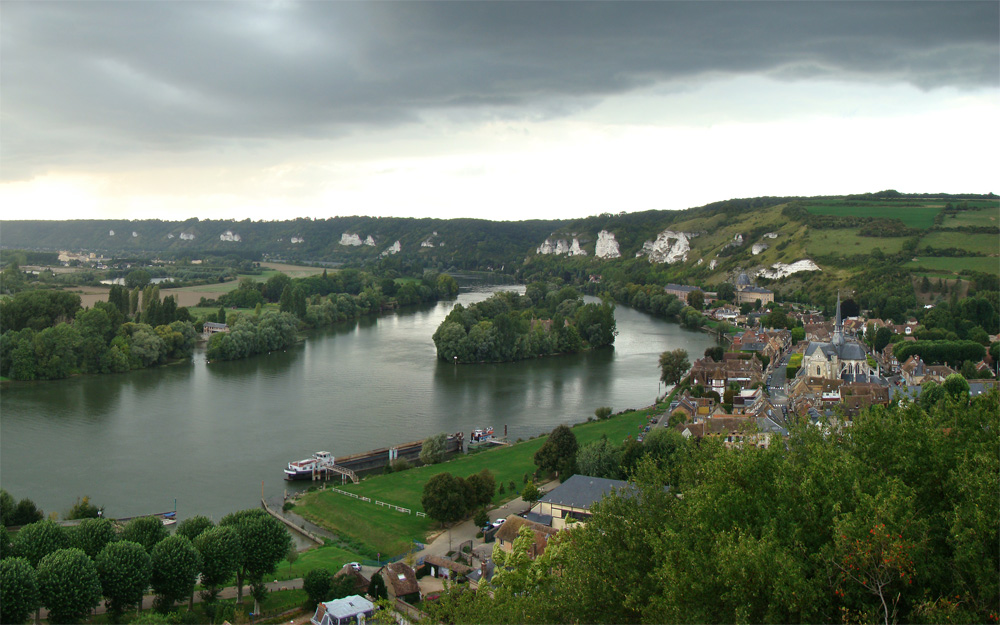|
Château Gaillard
Château Gaillard () is a medieval castle ruin overlooking the River Seine above the commune of Les Andelys, in the French department of Eure, in Normandy. It is located some north-west of Paris and from Rouen. Construction began in 1196 under the auspices of Richard the Lionheart, who was simultaneously King of England and feudal Duke of Normandy. The castle was expensive to build, but the majority of the work was done in an unusually short period of time. It took just two years and, at the same time, the town of Petit Andely was constructed. Château Gaillard has a complex and advanced design, and uses early principles of concentric fortification; it was also one of the earliest European castles to use machicolations. The castle consists of three enclosures separated by dry moats, with a keep in the inner enclosure. Château Gaillard was captured in 1204 by the king of France, Philip II, after a lengthy siege. In the mid-14th century, the castle was the residence of th ... [...More Info...] [...Related Items...] OR: [Wikipedia] [Google] [Baidu] |
Les Andelys
Les Andelys (; Norman: ''Les Aundelys'') is a commune in the northern French department of Eure, in Normandy. Geography It lies on the Seine, about northeast of Évreux. The commune is divided into two parts, Grand-Andely (located about from the Siene) and Petit-Andely (situated on the right bank of the Seine). History Grand Andely, founded, according to tradition, in the 6th century, has a church (13th, 14th and 15th centuries) parts of which are of fine late Gothic and Renaissance architecture. The works of art in the interior include beautiful stained glass of the latter period. Other interesting buildings are the hôtel du Grand Cerf dating from the first half of the 16th century, and the chapel of Sainte-Clotilde, close by a spring which, owing to its supposed healing powers, is the object of a pilgrimage. Grand Andely has a statue of Nicolas Poussin, a native of the place. Petit Andely sprang up at the foot of the eminence on which stands the Château Gaillard, now ... [...More Info...] [...Related Items...] OR: [Wikipedia] [Google] [Baidu] |
Eure
Eure () is a department in Normandy in Northwestern France, named after the river Eure. Its prefecture is Évreux. In 2019, Eure had a population of 599,507.Populations légales 2019: 27 Eure INSEE History Eure is one of the original 83 departments created during the on 4 March 1790. It was created from part of the former of Normandy. The name in fact is taken from the Eure river flowing mainly in this d ...[...More Info...] [...Related Items...] OR: [Wikipedia] [Google] [Baidu] |
Inner Bailey
The inner bailey or inner ward of a castle is the strongly fortified enclosure at the heart of a medieval castle.Friar, Stephen (2003). ''The Sutton Companion to Castles'', Sutton Publishing, Stroud, 2003, p. 22. It is protected by the outer ward and, sometimes also a '' Zwinger'', moats, a curtain wall and other outworks. Depending on topography it may also be called an upper bailey or upper ward. The inner bailey enclosed the most important living quarters and defensive elements for the lord and his family, e.g. the great hall, the '' palas'', the tower house and the keep or '' bergfried''. The castle well or cistern was usually found in the inner bailey, because water supplies were particularly important in the past in order to be able to withstand a siege for any length of time. The inner bailey is usually the oldest part of a castle, because it contains those buildings that were the first to be built during its construction. It often has flanking towers that enabled ... [...More Info...] [...Related Items...] OR: [Wikipedia] [Google] [Baidu] |
French Ministry Of Culture
The Ministry of Culture (french: Ministère de la Culture) is the ministry of the Government of France in charge of national museums and the . Its goal is to maintain the French identity through the promotion and protection of the arts (visual, plastic, theatrical, musical, dance, architectural, literary, televisual and cinematographic) on national soil and abroad. Its budget is mainly dedicated to the management of the (six national sites and hundred decentralised storage facilities) and the regional (culture centres). Its main office is in the in the 1st arrondissement of Paris on the . It is headed by the Minister of Culture, a cabinet member. The current officeholder has been since 20 May 2022. History Deriving from the Italian and Burgundian courts of the Renaissance, the notion that the state had a key role to play in the sponsoring of artistic production and that the arts were linked to national prestige was found in France from at least the 16th century on. Dur ... [...More Info...] [...Related Items...] OR: [Wikipedia] [Google] [Baidu] |
Monument Historique
''Monument historique'' () is a designation given to some national heritage sites in France. It may also refer to the state procedure in France by which National Heritage protection is extended to a building, a specific part of a building, a collection of buildings, a garden, a bridge, or other structure, because of their importance to France's architectural and historical cultural heritage. Both public and privately owned structures may be listed in this way, as well as movable objects. As of 2012 there were 44,236 monuments listed. The term "classification" is reserved for designation performed by the French Ministry of Culture (France), Ministry of Culture for a monument of national-level significance. Monuments of lesser significance may be "inscribed" by various regional entities. Buildings may be given the classification (or inscription) for either their exteriors or interiors. A monument's designation could be for a building's décor, its furniture, a single room, or eve ... [...More Info...] [...Related Items...] OR: [Wikipedia] [Google] [Baidu] |


.jpg)